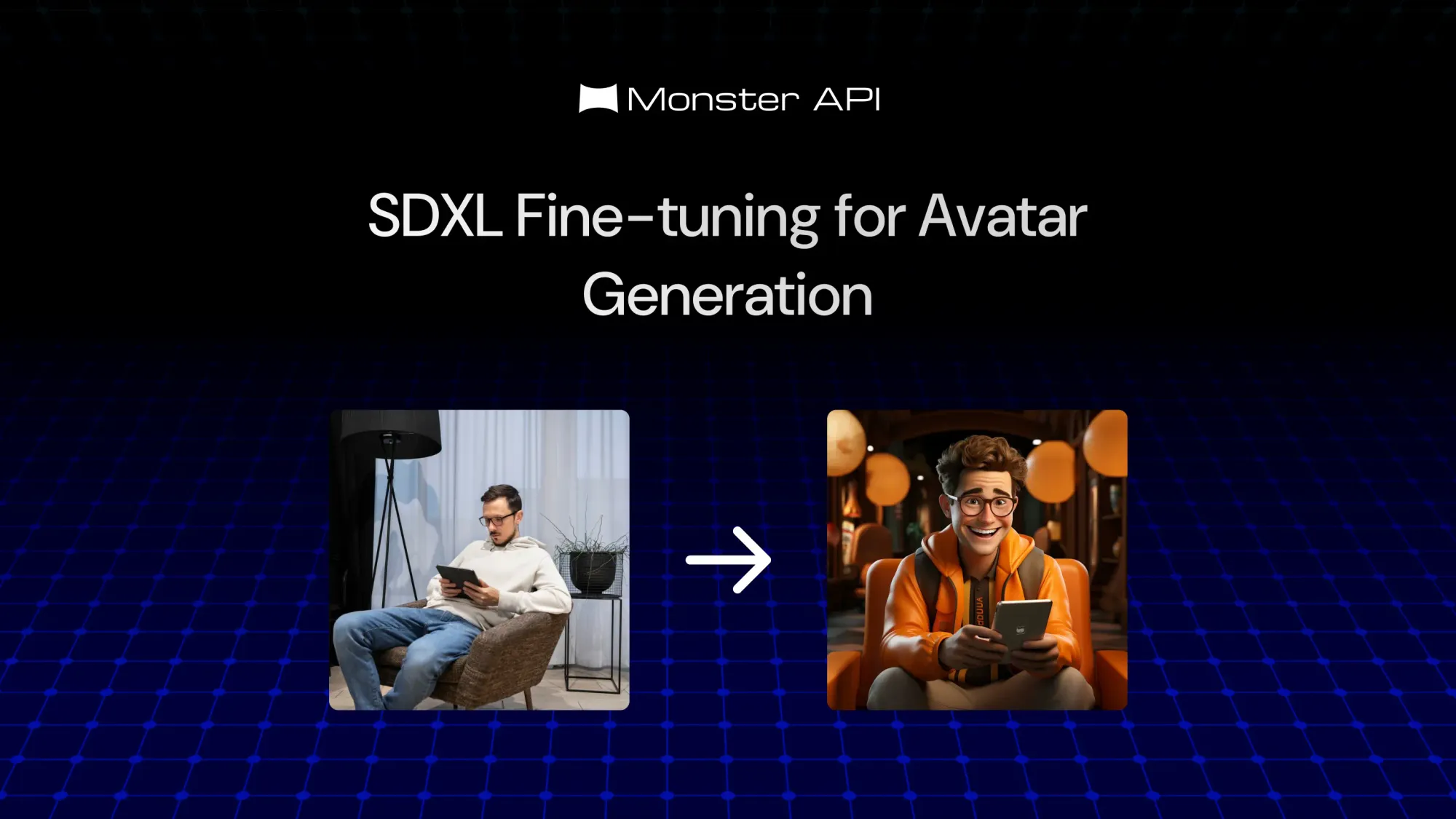How to Fine-tune SDXL for Avatar Generation on MonsterAPI
Convert your images into classy avatars by fine-tuning SDXL In just 3 steps, fine-tune SDXL and make your personal avatar generation agent.

As AI image generation continues to advance, the ability to create fine-tuned models has opened up exciting applications like custom avatar creation. Fine-tuning Stable Diffusion XL (SDXL) models for specific outputs, such as avatars, allows you to apply unique styles and features, building from a general-purpose model into a specialized one.
MonsterAPI offers a seamless way to fine-tune SDXL for avatar generation, giving you access to powerful models and robust dataset integration options. In this guide, we’ll walk through the process of fine-tuning SDXL for avatar creation using MonsterAPI, discussing the differences between the original model and the fine-tuned avatar version to help you achieve the results you want.
Why Fine-tune SDXL for Avatar Generation?
SDXL models are known for their versatile image generation capabilities and have produced impressive results in various styles and contexts. However, using the general SDXL model directly might not achieve the specific look and style needed for unique avatars. Fine-tuning SDXL models enables them to learn from a custom dataset, allowing you to produce high-quality avatars with personalized traits and artistic style.
With MonsterAPI, fine-tuning SDXL for avatar generation becomes straightforward, thanks to its optimized infrastructure, pre-integrated models, and flexible dataset options.
Step 1: Choosing the Right Model on MonsterAPI
MonsterAPI supports several models for fine-tuning SDXL for avatar generation:
- stabilityai/stable-diffusion-xl-base-1.0: Known for high detail and versatility, ideal for high-quality avatars with unique features.
- stabilityai/stable-diffusion-2: A reliable model with strong stability and adaptability across different image types.
- stabilityai/stable-diffusion-2-1: An updated version with enhanced quality, detail, and style flexibility.
For our example, we’ll use stabilityai/stable-diffusion-xl-base-1.0 due to its impressive quality for generating detailed, customizable avatars.
Step 2: Preparing the Dataset for Fine-tuning
To fine-tune SDXL for avatar generation, you’ll need a dataset that reflects the style and attributes you want in your avatars. MonsterAPI supports the following dataset sources:
- s3_presigned_link: Upload your dataset to an S3 bucket and provide a presigned link for access. This is efficient and secure.
- Custom Datasets: You can upload custom datasets directly to MonsterAPI for quick integration.
- Manual Bucket Access: If your dataset is stored in a private cloud storage bucket, you can manually provide access credentials for retrieval.
For this tutorial, we’ll use a custom dataset that includes Discord-style avatars to train our model. This dataset is pre-labeled and curated with a variety of avatar-like images, allowing the model to learn distinctive avatar features (e.g., facial expressions, various head angles, and clothing styles) commonly used in online profiles. Using a specific dataset like this ensures that our model produces consistent, high-quality avatars aligned with modern digital aesthetics.
Step 3: Fine-tuning the Model
Once you’ve selected your model and dataset, it’s time to start the fine-tuning process. Follow these steps to fine-tune SDXL for avatars on MonsterAPI:
- Navigate to the MonsterAPI Dashboard: Log in to MonsterAPI and go to the Fine-tuning section.
- Select Your Base Model: Choose `stabilityai/stable-diffusion-xl-base-1.0` as the base model.
- Upload Your Dataset: Depending on the dataset source, upload it or link to it from your preferred source (e.g., using the S3 presigned link).
- Adjust Hyperparameters: Fine-tuning requires setting some parameters:
- Steps: Choose an appropriate number of steps (e.g., 500–1000) to ensure enough training without overfitting.
- Learning Rate: Set a learning rate appropriate for SDXL models (e.g., 1e-5).
- Guidance Scale: This helps control the model's adherence to the prompt; a scale between 10–15 usually works well for avatar styles.
- Start Fine-tuning: After configuring these settings, initiate the fine-tuning. MonsterAPI will handle the heavy lifting, providing status updates as the model trains.
Step 4: Deploying Your Avatar Model
Once your SDXL model is fine-tuned for avatar generation, deploying it on MonsterAPI is easy. You can choose between One-Click Deployment or a Custom Deployment option based on your preference.
Option 1: One-Click Deployment
With MonsterAPI’s streamlined deployment, you can deploy your fine-tuned SDXL model in a single click:
- Be on your fine tuning page on MonsterAPI.
- Click on "Deploy Model" from the action bar to launch your model with just one click.
And that’s it! Your avatar generator will be live in no time.
Option 2: Custom Deployment
For more control over the setup, follow these steps:
- Go to Deploy from the sidebar.
- Select SDXL Deployment from the options.
- Choose your fine-tuned model and provide the Dreambooth Adapter Path to link the specific configurations.
Click Deploy and that’s it! MonsterAPI will handle the rest of the deployment, making the process quick and reliable.
With these steps, you’re now ready to generate custom avatars directly from your fine-tuned SDXL model on MonsterAPI.
Conclusion
Fine-tuning SDXL for avatar generation on MonsterAPI provides a powerful way to create unique, custom avatar images tailored to specific styles or themes. With access to robust models, easy dataset integration, and a simple deployment process, MonsterAPI empowers users to turn their vision into high-quality avatar images.
Whether you’re building personalized content or adding a creative touch to your brand, fine-tuned avatar models provide flexibility and professional results.
Get started today on MonsterAPI and unlock the full potential of SDXL fine-tuning for avatar generation!

